

Mind Maps for Essay Writing: A Comprehensive Guide with Examples and Tips
5 minutes read
Mastering essay writing is an essential skill for academic success. One valuable tool to enhance this skill is mind mapping, a dynamic and visual approach to organize thoughts. This article will guide you through the benefits, creation process, practical examples, and expert tips for effective mind mapping.
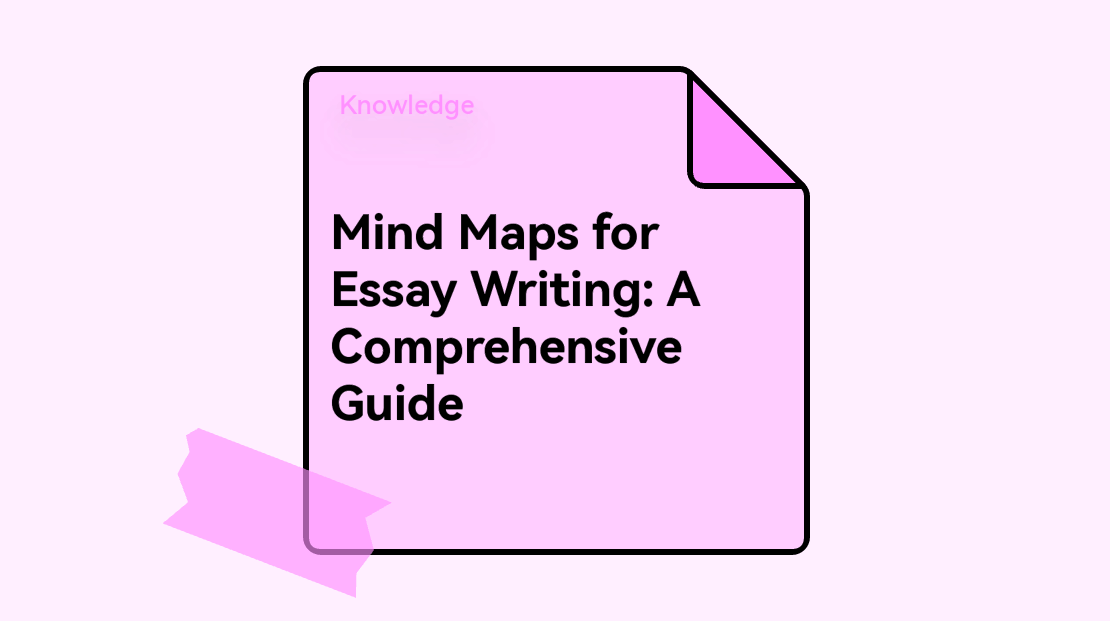
Understanding Mind Maps: Definition and Benefits
A Mind Map is a powerful graphic technique which provides a universal key to unlock the potential of the brain. It harnesses the full range of cortical skills – word, image, number, logic, rhythm, colour and spatial awareness – in a single, uniquely powerful manner.
Utilizing mind maps in essay writing offers several benefits. Not only does it provide a visually engaging way to organize ideas, but it also enhances understanding and memory recall. The science behind this phenomenon lies in the way our brain works. By representing information spatially and with images and color, mind mapping stimulates the brain in a much more rich and varied way than traditional note taking.
How to Create a Mind Map for an Essay
Mind mapping is an easy process which can be mastered with practice. Here's a step-by-step guide:
- Start in the center : Write your main idea or essay prompt in the center of the page and draw a circle around it.
- Branch out : From your central idea, draw lines out towards the edges of your page representing main thoughts or ideas related to your topic. At the end of each line, write a single word or phrase that summarizes the point, then draw a circle around that word or phrase.
- Add details : Draw smaller lines branching off from each main idea line that represent supporting details. At the end of these lines, write a brief detail or example and circle it.
- Colour your thoughts : Add colours to your different ideas to highlight them. Use pictures or symbols wherever applicable.
Essential tools for mind mapping range from simple pen and paper to advanced mind mapping software like Boardmix or EdrawMind.
How to Use Mind Maps for Effective Essay Writing
Mastering the use of mind maps for essay writing entails three primary steps – identifying an apt essay topic, kickstarting the research process, and finally, outlining your essay within a mind map. Here's a detailed exploration of these stages:
Step 1: Using a Mind Map to Find a Good Topic for Your Essay
Selecting an engaging and manageable topic forms the bedrock of an impactful essay. Mind mapping can be instrumental in this process by helping to generate and connect ideas creatively and logically.
Brainstorming Topic Ideas with a Mind Map
To brainstorm topics, start by jotting down a general area of interest at the center of your mind map. Let's say, "Climate Change." Now, let your mind flow freely and create branches from this central node, each representing a different aspect or question related to Climate Change - "Causes," "Effects," "Solutions," "Controversies," etc. From these primary branches, draw secondary branches for further thoughts, arguments, or subtopics. After creating this mind map, assess the feasibility and interest level of each potential essay topic, and choose the one that resonates the most with you.
Step 2: Start the Research Process
Once you've chosen your topic, it's time to delve into research. A well-researched essay strengthens your arguments and adds credibility to your work.
Collecting Research in a Mind Map
Begin by creating a new mind map with your chosen topic at the center. As you start reading relevant resources - books, articles, or websites - extract key points and note them as branches on your mind map. For instance, under the "Causes" branch for Climate Change, you could add sub-branches like "Industrialization," "Deforestation," or "Carbon Emissions." Under each of these, note relevant data or quotations from your sources. This approach helps to visualize how various bits of information relate to each other and makes it easier to structure your essay later.
Step 3: Outlining Essay Paper in a Mind Map
Having gathered adequate research material, it's time to structure it coherently through an essay outline. Creating this outline within a mind map ensures that no crucial point is overlooked and allows you to visualize the logical flow of your essay.
From your research mind map, create another one specifically for your essay outline. The central node should be your essay title or thesis statement. Create major branches for each key argument or point you plan to discuss. Attach supporting evidence, examples or sub-arguments as sub-branches. Under each major branch, ensure that there is a claim or unique viewpoint that you will defend or explain in your essay.
In essence, this mind map will act as the skeleton of your essay, providing a clear roadmap for your writing process.
5 Examples of Mind Maps for Essay Writing
Analyzing examples of mind maps for essay writing can provide a better understanding of how this powerful brainstorming tool works. Here are five detailed examples that demonstrate different ways to utilize mind mapping in academic writing.
Example 1: Argumentative Essay Mind Map
Let's consider a mind map developed for an argumentative essay about "Climate Change". The central node, in this case, states "Climate Change". From this central idea, branches emerge that represent the main arguments for the essay. One branch could say "Evidence of Climate Change," with sub-branches exploring different scientific studies that support climate change. Another branch might state "Effects of Climate Change," delving into the impact on polar ice caps, rising sea levels, and wildlife extinction. A third branch may argue "Solutions to Climate Change," examining renewable energy sources, deforestation reduction, and government policies. Each branch further divides into smaller branches providing details, examples, or counterarguments.

Example 2: Descriptive Essay Mind Map
Now, imagine a descriptive essay about "A Winter Morning". The central node would depict the essay's main theme. Major branches could represent sensory details, such as sight, sound, touch, taste, and smell. For instance, the sight branch might have sub-branches like "white snow," "gray skies," or "bare trees." Each of these would break down into more detailed descriptions.
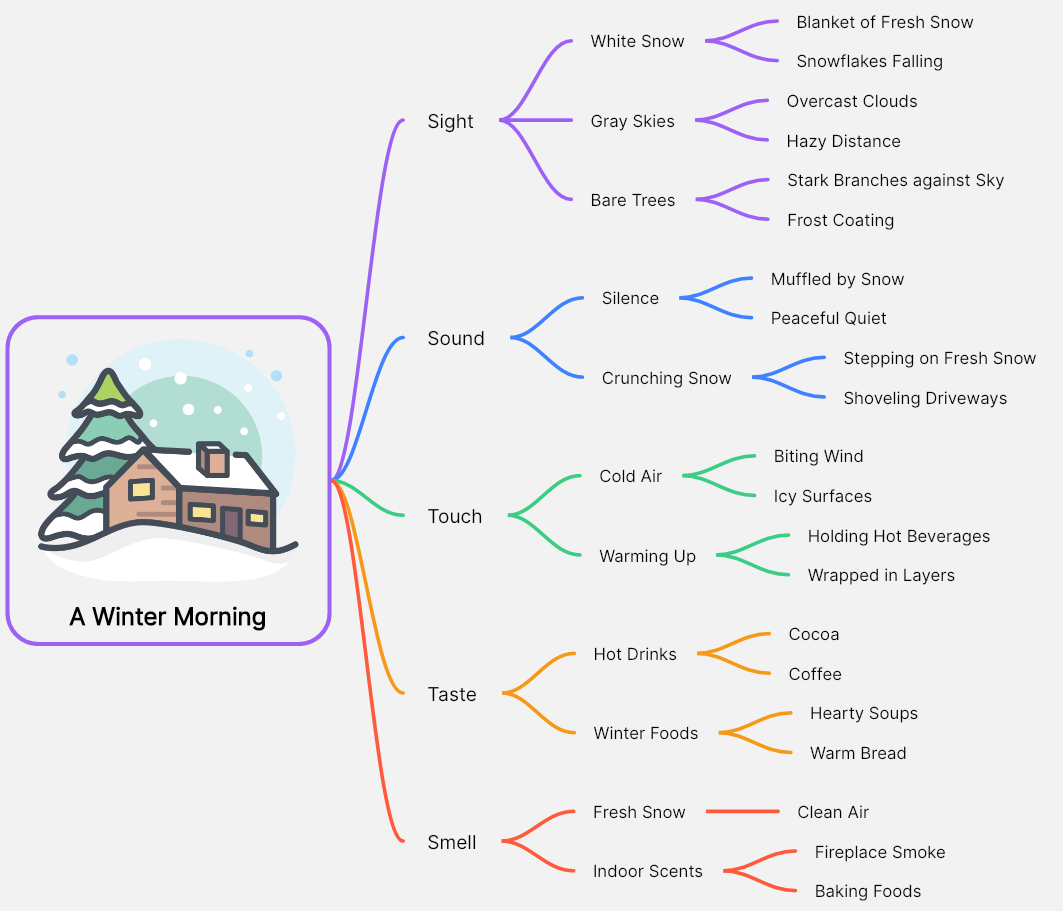
Example 3: Compare and Contrast Essay Mind Map
In a compare and contrast essay on "Traditional Classrooms vs. Online Learning," each of these educational modes could form a major branch from the central node. Sub-branches would then depict aspects for comparison, such as learning flexibility, student-teacher interaction, technology usage, assessment methods, etc. Each of these sub-branches would further branch out into specific points for both traditional classrooms and online learning environments.
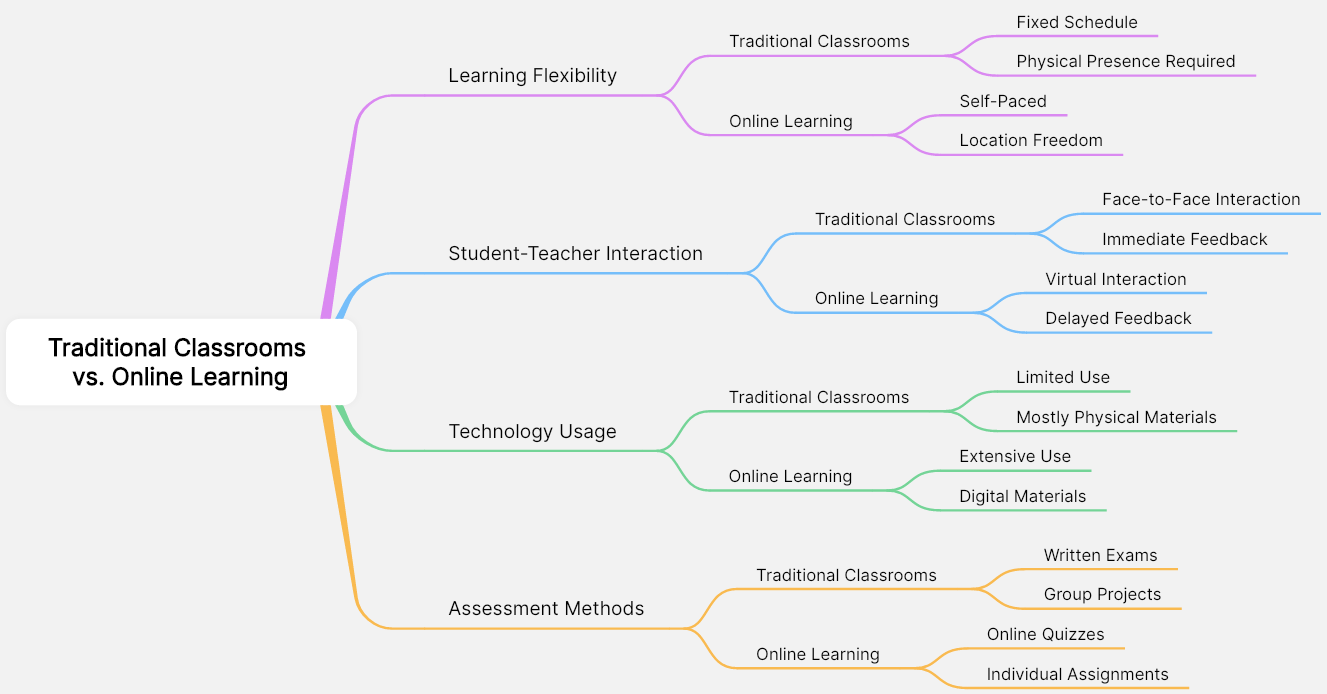
Example 4: Cause and Effect Essay Mind Map
For a cause and effect essay on "Smoking", one major branch might represent "Causes of Smoking" such as peer pressure, stress, and advertising influence. Another major branch could depict the "Effects of Smoking," branching out into health impacts (lung cancer, heart disease), financial costs, and societal effects. Each point could further elaborate through additional branches.
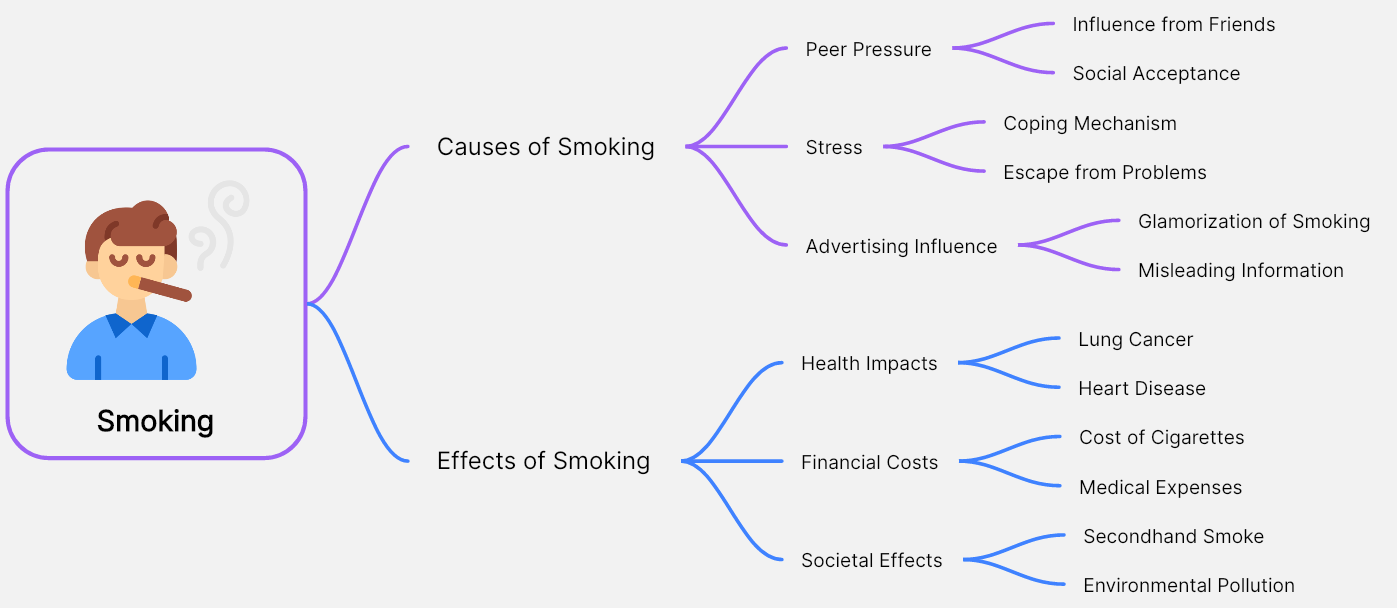
Example 5: Narrative Essay Mind Map
A narrative essay on "My First Camping Trip" would involve major branches for each key event in the story's progression - setting up camp, exploring the forest, facing a wildlife encounter, handling a campfire accident. Sub-branches off these main events would provide specific details and dialogue to enrich the narrative.
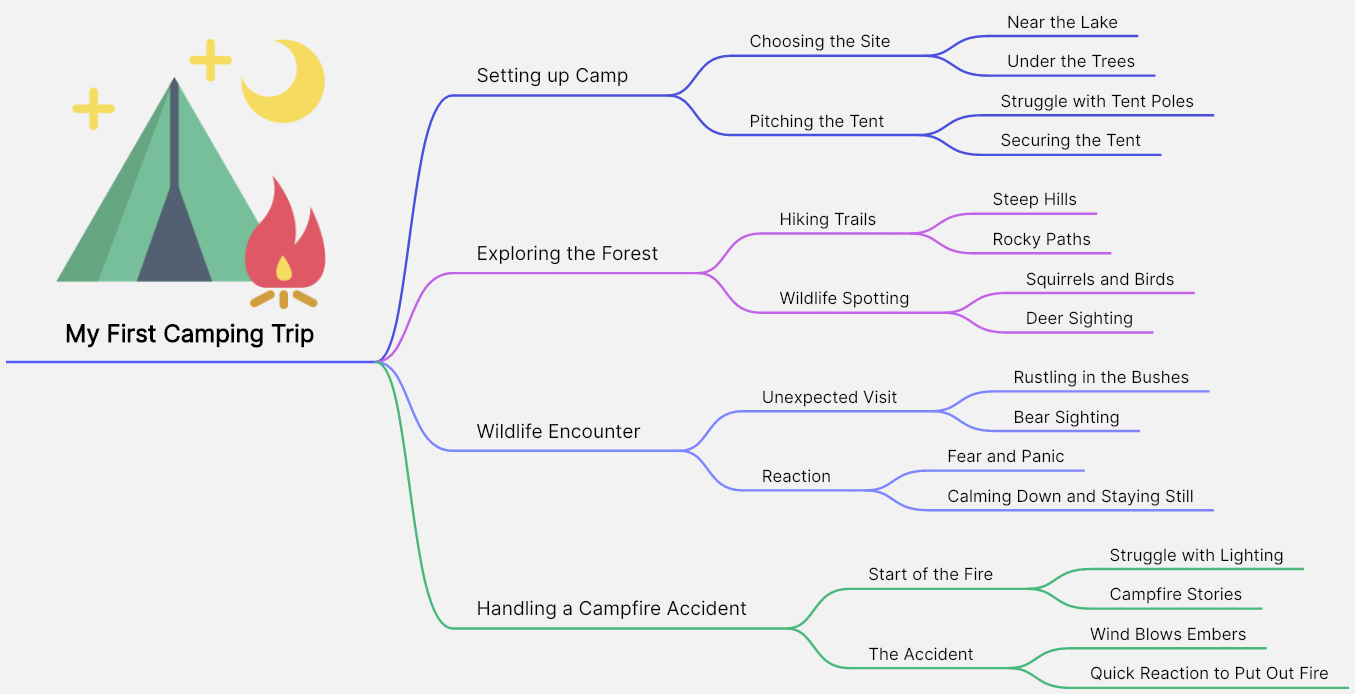
Some Tips and Tricks for Effective Mind Mapping
For effective mind mapping, follow these tips:
- Be creative and make your map vibrant.
- Use single words or simple phrases for information brevity.
- Keep your mind map clear by using radial hierarchy or outlines to embrace your branches.
- Review regularly to reinforce memory.
While creating a mind map, avoid cluttering information on one branch. Use balance across your mind map while distributing information.
Reinventing Essay Writing with Mind Maps
Mind mapping, when mastered, can be a game-changer in your academic writing. It helps organise thoughts, enhances memory and understanding, and can make the essay writing process smoother and more efficient.
Through this guide, you've learned the benefits of mind mapping, how to create a mind map, seen some examples, got expert tips, and learned how to incorporate it into your essay writing process. Now it's time to put this knowledge into practice and start revolutionizing your essay writing with mind maps!
Join Boardmix to collaborate with your team.
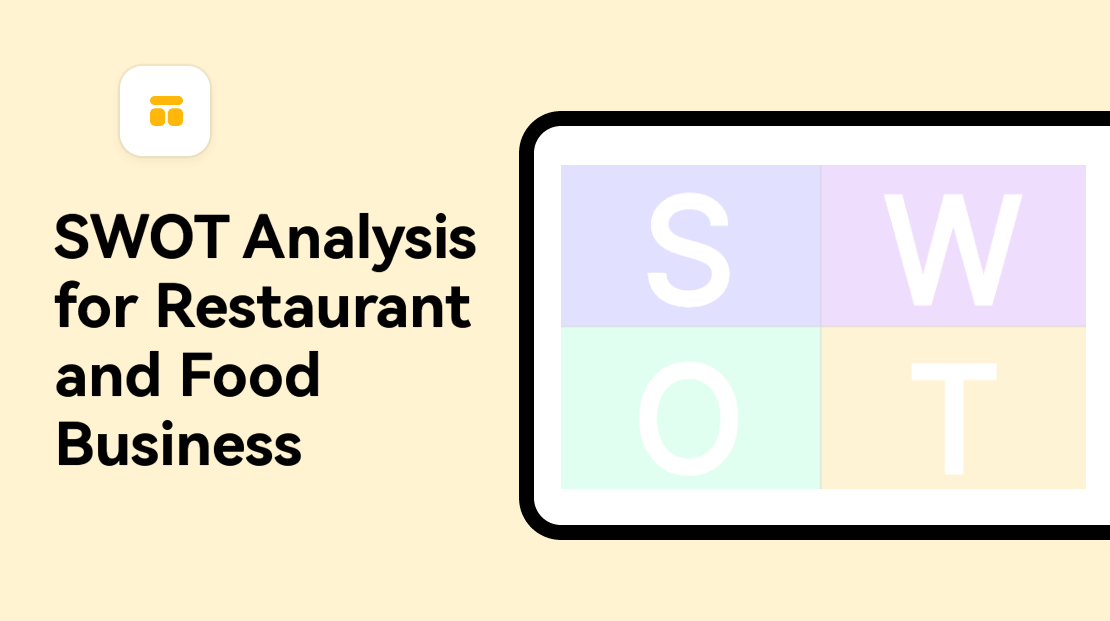
Mastering SWOT Analysis for Restaurant and Food Business
![essay tree map Quick Percentage Bar Diagram Guide [Explained with Examples in Real-Life]](https://cms.boardmix.com/images/articles/percentage-bar-diagram-examples-cover.png)
Quick Percentage Bar Diagram Guide [Explained with Examples in Real-Life]
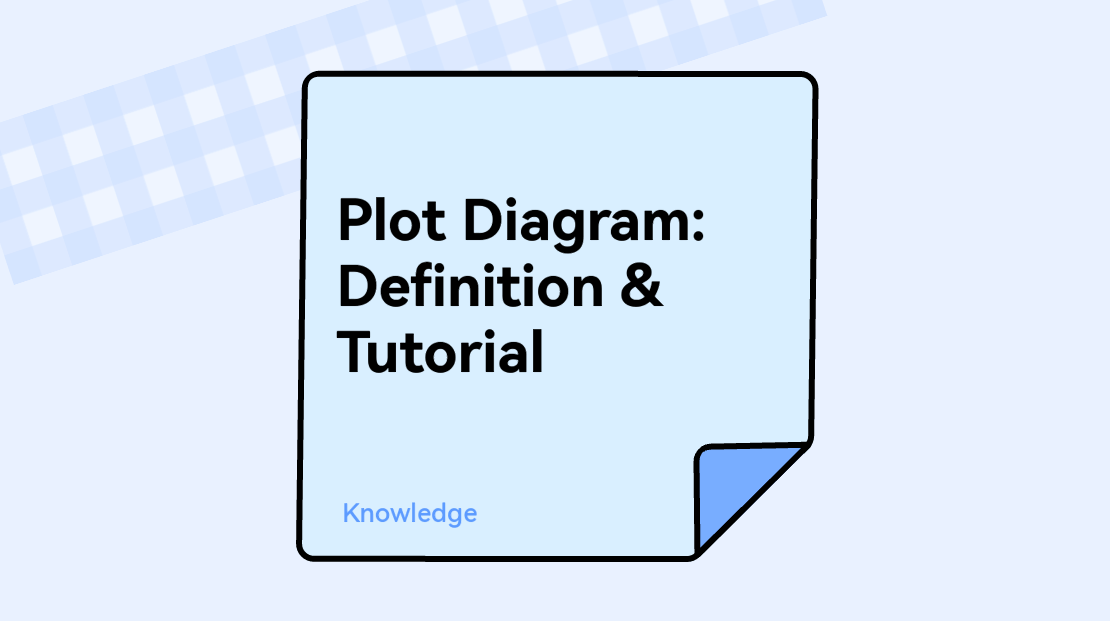
Plot Diagram: Definition & Tutorial
Have a language expert improve your writing
Run a free plagiarism check in 10 minutes, generate accurate citations for free.
- Knowledge Base
- How to structure an essay: Templates and tips
How to Structure an Essay | Tips & Templates
Published on September 18, 2020 by Jack Caulfield . Revised on July 23, 2023.
The basic structure of an essay always consists of an introduction , a body , and a conclusion . But for many students, the most difficult part of structuring an essay is deciding how to organize information within the body.
Instantly correct all language mistakes in your text
Upload your document to correct all your mistakes in minutes

Table of contents
The basics of essay structure, chronological structure, compare-and-contrast structure, problems-methods-solutions structure, signposting to clarify your structure, other interesting articles, frequently asked questions about essay structure.
There are two main things to keep in mind when working on your essay structure: making sure to include the right information in each part, and deciding how you’ll organize the information within the body.
Parts of an essay
The three parts that make up all essays are described in the table below.
Order of information
You’ll also have to consider how to present information within the body. There are a few general principles that can guide you here.
The first is that your argument should move from the simplest claim to the most complex . The body of a good argumentative essay often begins with simple and widely accepted claims, and then moves towards more complex and contentious ones.
For example, you might begin by describing a generally accepted philosophical concept, and then apply it to a new topic. The grounding in the general concept will allow the reader to understand your unique application of it.
The second principle is that background information should appear towards the beginning of your essay . General background is presented in the introduction. If you have additional background to present, this information will usually come at the start of the body.
The third principle is that everything in your essay should be relevant to the thesis . Ask yourself whether each piece of information advances your argument or provides necessary background. And make sure that the text clearly expresses each piece of information’s relevance.
The sections below present several organizational templates for essays: the chronological approach, the compare-and-contrast approach, and the problems-methods-solutions approach.

Receive feedback on language, structure, and formatting
Professional editors proofread and edit your paper by focusing on:
- Academic style
- Vague sentences
- Style consistency
See an example

The chronological approach (sometimes called the cause-and-effect approach) is probably the simplest way to structure an essay. It just means discussing events in the order in which they occurred, discussing how they are related (i.e. the cause and effect involved) as you go.
A chronological approach can be useful when your essay is about a series of events. Don’t rule out other approaches, though—even when the chronological approach is the obvious one, you might be able to bring out more with a different structure.
Explore the tabs below to see a general template and a specific example outline from an essay on the invention of the printing press.
- Thesis statement
- Discussion of event/period
- Consequences
- Importance of topic
- Strong closing statement
- Claim that the printing press marks the end of the Middle Ages
- Background on the low levels of literacy before the printing press
- Thesis statement: The invention of the printing press increased circulation of information in Europe, paving the way for the Reformation
- High levels of illiteracy in medieval Europe
- Literacy and thus knowledge and education were mainly the domain of religious and political elites
- Consequence: this discouraged political and religious change
- Invention of the printing press in 1440 by Johannes Gutenberg
- Implications of the new technology for book production
- Consequence: Rapid spread of the technology and the printing of the Gutenberg Bible
- Trend for translating the Bible into vernacular languages during the years following the printing press’s invention
- Luther’s own translation of the Bible during the Reformation
- Consequence: The large-scale effects the Reformation would have on religion and politics
- Summarize the history described
- Stress the significance of the printing press to the events of this period
Essays with two or more main subjects are often structured around comparing and contrasting . For example, a literary analysis essay might compare two different texts, and an argumentative essay might compare the strengths of different arguments.
There are two main ways of structuring a compare-and-contrast essay: the alternating method, and the block method.
Alternating
In the alternating method, each paragraph compares your subjects in terms of a specific point of comparison. These points of comparison are therefore what defines each paragraph.
The tabs below show a general template for this structure, and a specific example for an essay comparing and contrasting distance learning with traditional classroom learning.
- Synthesis of arguments
- Topical relevance of distance learning in lockdown
- Increasing prevalence of distance learning over the last decade
- Thesis statement: While distance learning has certain advantages, it introduces multiple new accessibility issues that must be addressed for it to be as effective as classroom learning
- Classroom learning: Ease of identifying difficulties and privately discussing them
- Distance learning: Difficulty of noticing and unobtrusively helping
- Classroom learning: Difficulties accessing the classroom (disability, distance travelled from home)
- Distance learning: Difficulties with online work (lack of tech literacy, unreliable connection, distractions)
- Classroom learning: Tends to encourage personal engagement among students and with teacher, more relaxed social environment
- Distance learning: Greater ability to reach out to teacher privately
- Sum up, emphasize that distance learning introduces more difficulties than it solves
- Stress the importance of addressing issues with distance learning as it becomes increasingly common
- Distance learning may prove to be the future, but it still has a long way to go
In the block method, each subject is covered all in one go, potentially across multiple paragraphs. For example, you might write two paragraphs about your first subject and then two about your second subject, making comparisons back to the first.
The tabs again show a general template, followed by another essay on distance learning, this time with the body structured in blocks.
- Point 1 (compare)
- Point 2 (compare)
- Point 3 (compare)
- Point 4 (compare)
- Advantages: Flexibility, accessibility
- Disadvantages: Discomfort, challenges for those with poor internet or tech literacy
- Advantages: Potential for teacher to discuss issues with a student in a separate private call
- Disadvantages: Difficulty of identifying struggling students and aiding them unobtrusively, lack of personal interaction among students
- Advantages: More accessible to those with low tech literacy, equality of all sharing one learning environment
- Disadvantages: Students must live close enough to attend, commutes may vary, classrooms not always accessible for disabled students
- Advantages: Ease of picking up on signs a student is struggling, more personal interaction among students
- Disadvantages: May be harder for students to approach teacher privately in person to raise issues
An essay that concerns a specific problem (practical or theoretical) may be structured according to the problems-methods-solutions approach.
This is just what it sounds like: You define the problem, characterize a method or theory that may solve it, and finally analyze the problem, using this method or theory to arrive at a solution. If the problem is theoretical, the solution might be the analysis you present in the essay itself; otherwise, you might just present a proposed solution.
The tabs below show a template for this structure and an example outline for an essay about the problem of fake news.
- Introduce the problem
- Provide background
- Describe your approach to solving it
- Define the problem precisely
- Describe why it’s important
- Indicate previous approaches to the problem
- Present your new approach, and why it’s better
- Apply the new method or theory to the problem
- Indicate the solution you arrive at by doing so
- Assess (potential or actual) effectiveness of solution
- Describe the implications
- Problem: The growth of “fake news” online
- Prevalence of polarized/conspiracy-focused news sources online
- Thesis statement: Rather than attempting to stamp out online fake news through social media moderation, an effective approach to combating it must work with educational institutions to improve media literacy
- Definition: Deliberate disinformation designed to spread virally online
- Popularization of the term, growth of the phenomenon
- Previous approaches: Labeling and moderation on social media platforms
- Critique: This approach feeds conspiracies; the real solution is to improve media literacy so users can better identify fake news
- Greater emphasis should be placed on media literacy education in schools
- This allows people to assess news sources independently, rather than just being told which ones to trust
- This is a long-term solution but could be highly effective
- It would require significant organization and investment, but would equip people to judge news sources more effectively
- Rather than trying to contain the spread of fake news, we must teach the next generation not to fall for it
Here's why students love Scribbr's proofreading services
Discover proofreading & editing
Signposting means guiding the reader through your essay with language that describes or hints at the structure of what follows. It can help you clarify your structure for yourself as well as helping your reader follow your ideas.
The essay overview
In longer essays whose body is split into multiple named sections, the introduction often ends with an overview of the rest of the essay. This gives a brief description of the main idea or argument of each section.
The overview allows the reader to immediately understand what will be covered in the essay and in what order. Though it describes what comes later in the text, it is generally written in the present tense . The following example is from a literary analysis essay on Mary Shelley’s Frankenstein .
Transitions
Transition words and phrases are used throughout all good essays to link together different ideas. They help guide the reader through your text, and an essay that uses them effectively will be much easier to follow.
Various different relationships can be expressed by transition words, as shown in this example.
Because Hitler failed to respond to the British ultimatum, France and the UK declared war on Germany. Although it was an outcome the Allies had hoped to avoid, they were prepared to back up their ultimatum in order to combat the existential threat posed by the Third Reich.
Transition sentences may be included to transition between different paragraphs or sections of an essay. A good transition sentence moves the reader on to the next topic while indicating how it relates to the previous one.
… Distance learning, then, seems to improve accessibility in some ways while representing a step backwards in others.
However , considering the issue of personal interaction among students presents a different picture.
If you want to know more about AI tools , college essays , or fallacies make sure to check out some of our other articles with explanations and examples or go directly to our tools!
- Ad hominem fallacy
- Post hoc fallacy
- Appeal to authority fallacy
- False cause fallacy
- Sunk cost fallacy
College essays
- Choosing Essay Topic
- Write a College Essay
- Write a Diversity Essay
- College Essay Format & Structure
- Comparing and Contrasting in an Essay
(AI) Tools
- Grammar Checker
- Paraphrasing Tool
- Text Summarizer
- AI Detector
- Plagiarism Checker
- Citation Generator
The structure of an essay is divided into an introduction that presents your topic and thesis statement , a body containing your in-depth analysis and arguments, and a conclusion wrapping up your ideas.
The structure of the body is flexible, but you should always spend some time thinking about how you can organize your essay to best serve your ideas.
An essay isn’t just a loose collection of facts and ideas. Instead, it should be centered on an overarching argument (summarized in your thesis statement ) that every part of the essay relates to.
The way you structure your essay is crucial to presenting your argument coherently. A well-structured essay helps your reader follow the logic of your ideas and understand your overall point.
Comparisons in essays are generally structured in one of two ways:
- The alternating method, where you compare your subjects side by side according to one specific aspect at a time.
- The block method, where you cover each subject separately in its entirety.
It’s also possible to combine both methods, for example by writing a full paragraph on each of your topics and then a final paragraph contrasting the two according to a specific metric.
You should try to follow your outline as you write your essay . However, if your ideas change or it becomes clear that your structure could be better, it’s okay to depart from your essay outline . Just make sure you know why you’re doing so.
Cite this Scribbr article
If you want to cite this source, you can copy and paste the citation or click the “Cite this Scribbr article” button to automatically add the citation to our free Citation Generator.
Caulfield, J. (2023, July 23). How to Structure an Essay | Tips & Templates. Scribbr. Retrieved April 15, 2024, from https://www.scribbr.com/academic-essay/essay-structure/
Is this article helpful?

Jack Caulfield
Other students also liked, comparing and contrasting in an essay | tips & examples, how to write the body of an essay | drafting & redrafting, transition sentences | tips & examples for clear writing, "i thought ai proofreading was useless but..".
I've been using Scribbr for years now and I know it's a service that won't disappoint. It does a good job spotting mistakes”
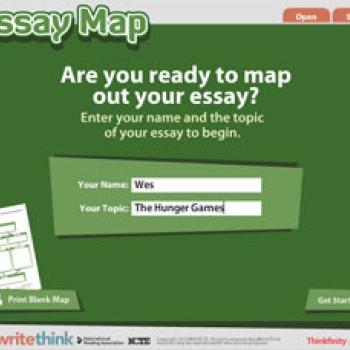
About this Interactive
Related resources.
Expository writing is an increasingly important skill for elementary, middle, and high school students to master. This interactive graphic organizer helps students develop an outline that includes an introductory statement, main ideas they want to discuss or describe, supporting details, and a conclusion that summarizes the main ideas. The tool offers multiple ways to navigate information including a graphic in the upper right-hand corner that allows students to move around the map without having to work in a linear fashion. The finished map can be saved, e-mailed, or printed.
- Student Interactives
- Strategy Guides
- Lesson Plans
- Calendar Activities
The Persuasion Map is an interactive graphic organizer that enables students to map out their arguments for a persuasive essay or debate.
This Strategy Guide describes the processes involved in composing and producing audio files that are published online as podcasts.
This strategy guide explains the writing process and offers practical methods for applying it in your classroom to help students become proficient writers.
This strategy guide clarifies the difference between persuasion and argumentation, stressing the connection between close reading of text to gather evidence and formation of a strong argumentative claim about text.
Students will identify how Martin Luther King Jr.'s dream of nonviolent conflict-resolution is reinterpreted in modern texts. Homework is differentiated to prompt discussion on how nonviolence is portrayed through characterization and conflict. Students will be formally assessed on a thesis essay that addresses the Six Kingian Principles of Nonviolence.
Students develop their reading, writing, research, and technology skills using graphic novels. As a final activity, students create their own graphic novels using comic software.
Students are encouraged to understand a book that the teacher reads aloud to create a new ending for it using the writing process.
While drafting a literary analysis essay (or another type of argument) of their own, students work in pairs to investigate advice for writing conclusions and to analyze conclusions of sample essays. They then draft two conclusions for their essay, select one, and reflect on what they have learned through the process.
Students analyze rhetorical strategies in online editorials, building knowledge of strategies and awareness of local and national issues. This lesson teaches students connections between subject, writer, and audience and how rhetorical strategies are used in everyday writing.
It's not easy surviving fourth grade (or third or fifth)! In this lesson, students brainstorm survival tips for future fourth graders and incorporate those tips into an essay.
Students explore the nature and structure of expository texts that focus on cause and effect and apply what they learned using graphic organizers and writing paragraphs to outline cause-and-effect relationships.
Students prepare an already published scholarly article for presentation, with an emphasis on identification of the author's thesis and argument structure.
- Print this resource
Explore Resources by Grade
- Kindergarten K
Layla Henry- Fancy Free in 4th- Blog
Fancy Ideas for the Everyday Classroom
How I Teach Writing & the Beauty of Flee Maps!
December 29, 2014 By fancyfreein4th
This year we only get 2 weeks off for Winter Break…I know, I know! I should be happy that I get an entire t-w-o weeks off but I am used to three weeks off! I feel like this year’s break has been stacked with activity after activity- and while I am enjoying these activities… I would love a second to just BE STILL! Today we had a wonderful day just being a family of four and hanging out! It. was. lovely.
While the kiddos napped I was able to post a product that one of my loyal TpT patrons asked me to create. Our district uses Thinking Maps and I incorporate them into every subject that I teach. I especially enjoy using them in writing. We always start out with a circle map which defines our topic in context and allows them to get all of the ideas out of their head and onto the paper.

I often have the students brainstorm on their own, then share 1 or 2 of their ideas with their elbow buddy and finally I crate a class circle map to create a massive list of ideas- which is especially helpful for hesitant writers.
After they are done brainstorming and have a good grasp on the writing prompt at hand and which genre we are focusing on we move onto the Beautiful Flee Map! A Flee Map is a hybrid of a Tree Map , which classifies and groups things, and a Flow Map, which sequences and orders events.
This is what it looks like and what goes in each box. It can be used for a 3 or 5 paragraph assignment. The students do not need to write in complete sentence on this. Bullet points and notes are fine. This serves as a map or plan that organizes all of their ideas and the things that they must cover in each section before they compose their first draft.

I use Flee maps for all writing, even in content writing and research reports. It is a cohesive way that they are comfortable with and they feel supported with the structure and format.
You can grab this *on sale now*, at my TpT store! Find it here and check my Facebook Page for a giveaway!
December 30, 2014 at 3:05 am
I love using Flee maps for writing!
Brandi Swinging for Success
December 30, 2014 at 8:26 pm
I'm sold! Buying it now. I've been using flee maps for years, but I really like how you set this up! Nicely done, Layla. : )
Ali Teaching Powered by Caffeine
Leave a Reply Cancel reply
Your email address will not be published. Required fields are marked *
Save my name, email, and website in this browser for the next time I comment.
Latest on Pinterest

Error: API requests are being delayed. New posts will not be retrieved for at least 5 minutes.
There may be an issue with the Instagram access token that you are using. Your server might also be unable to connect to Instagram at this time.
Free Editable Thinking Maps Templates for Teachers
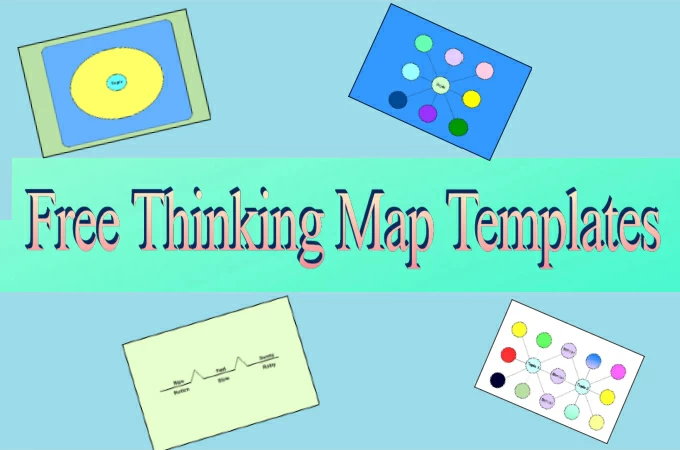
Thinking maps are some of the most common teaching materials used in schools. These maps are used as presentation material for an audience or simply as a chart that contains various information about a topic. There are eight types of these maps, and each are designed for a specific purpose and offers its own benefits. With that being said, if you want to know more about think maps, then you are on the right page. Read on to learn more about these map types and where you can find some of them.
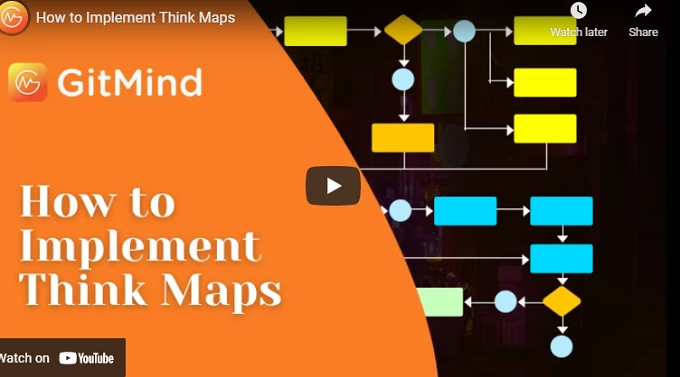
Thinking Map Types
Double bubble map, multi-flow map.
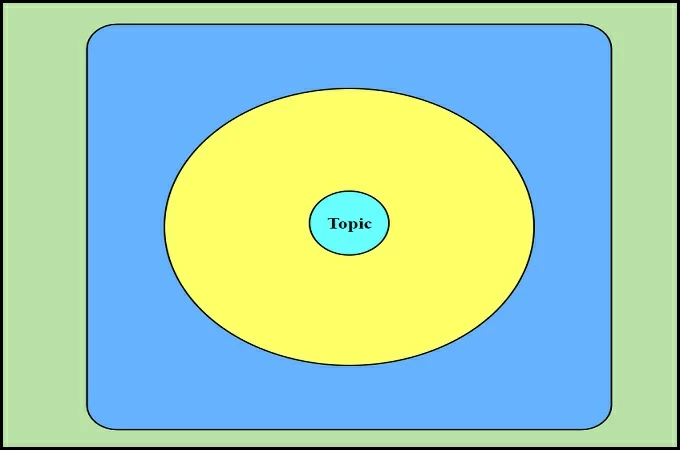
The first type and probably the simplest thinking maps type is the Circle Map . As the name suggests, it is a circle in shape. It is most commonly used for brainstorming sessions as it is perfect for capturing the free flow of information. Aside from that, it is the most straightforward map that you can draw with just a pen and paper. To create one, draw a circle and then write the topic inside it. After that, draw a bigger circle around the first one and then write all available information about the matter inside it. Lastly, draw a square around the larger circle, and write down your sources for the information you shared.
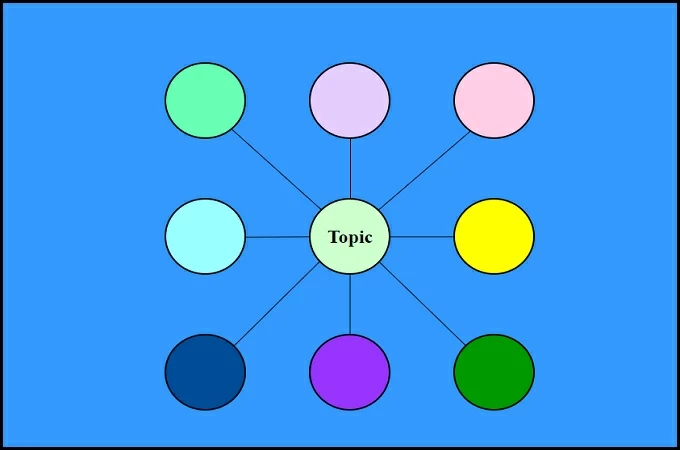
The next type of map that you can use is Bubble Map . This type of diagram is commonly used for analyzing a certain topic using adjectives. In general, it is perfect for character development discussions. The central topic is encircled in a bubble and connected to other bubbles, as many as you like. After that, fill each supporting bubble with adjectives describing the central topic. You can also use this map when introducing a new lesson in class, just like most teachers do.
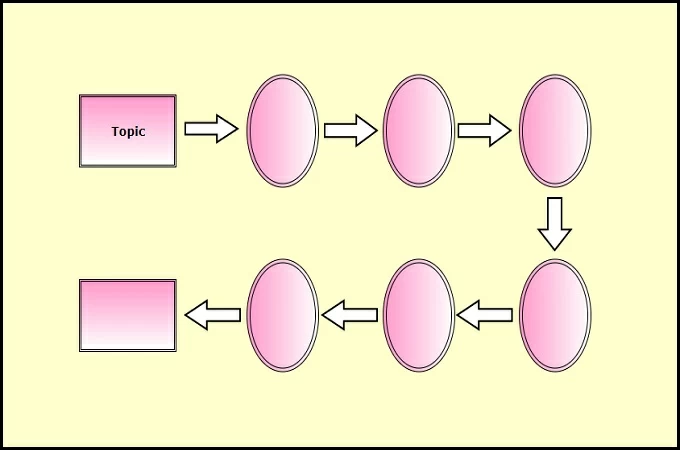
For a chart that shows a sequence or order, take advantage of Flow Maps . This map is probably the most recognizable among other types of thinking maps. This is because it is widely-used when providing step-by-step instructions, which is its primary function. A flow map or flow chart is also one of the most detailed maps that you can use because you can add various other things like images to each column. If you want to create one, start by creating a box and fill it up with the central topic. Then add succeeding boxes and fill them out with information of steps in a logical order.
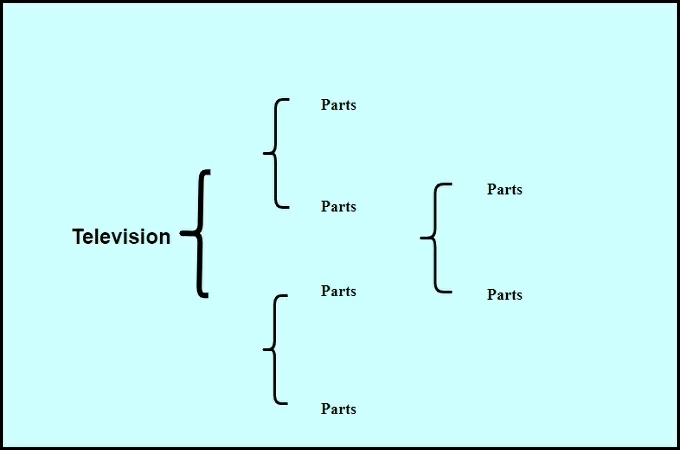
A brace map is often used for showing different components of a physical object. Unlike other thinking maps, a brace map is solely used for breaking down parts and cannot be used for abstract ideas. This map is great for showing and explaining how each component works to make up the central topic. So for example, if you want to break down the components of a Television, start with it as the primary topic. After that, use braces to identify each part of the entire Television device.
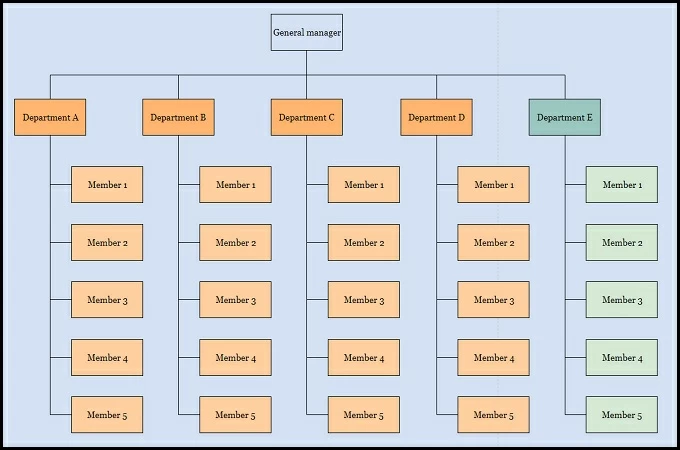
The tree map is frequently seen on bulletin boards and other public notice boards. The most recognizable feature of this map is its well-structured form. This map prioritizes the most important information at the top and trickles down to less necessary details as it flows downward. It is perfect for showing a company or organizational hierarchy or sorting out information according to their categories. Overall, it is one of the most useful thinking maps that you can easily create.
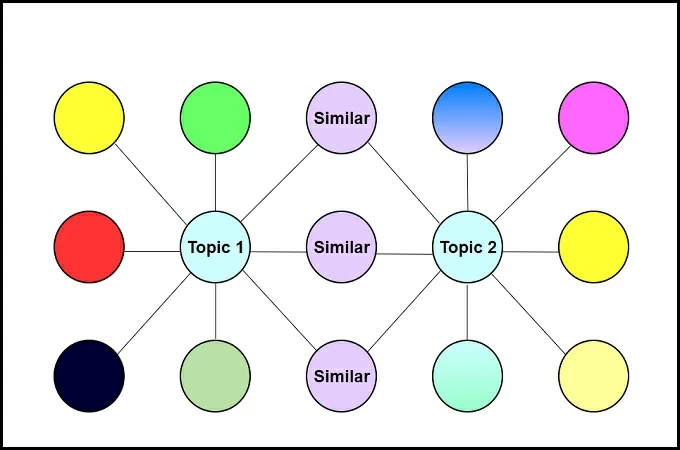
The name of the double bubble map is self-explanatory. The principle is the same as with the previous bubble diagram. You create two separate bubble maps with different topics and find the similarities between the two topics using overlapping bubbles. Upon a closer look, a double bubble map resembles a Venn diagram, only more organized and easier to understand.
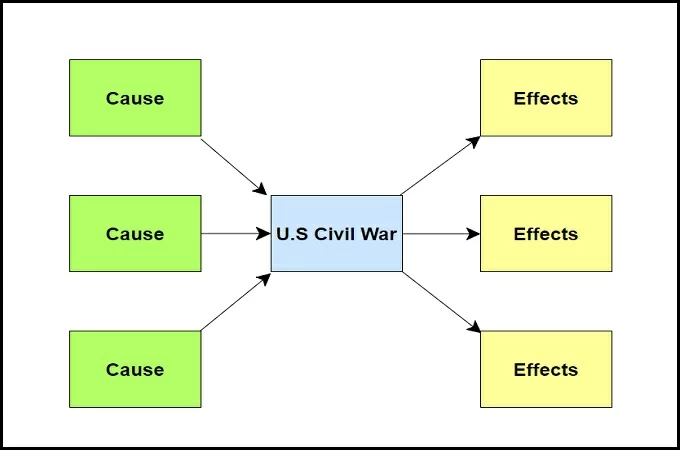
Multi-flow maps are commonly used to show causal relationships of events and such. This map is simple and easy to understand, making it perfect for school presentations and public forums. Apart from that, this map is versatile enough that you can use it to show only the cause without the effect and vice-versa. However, the whole point of using a multi-flow map is to show the relationship between the central topic and the cause or effect and not the other way around.
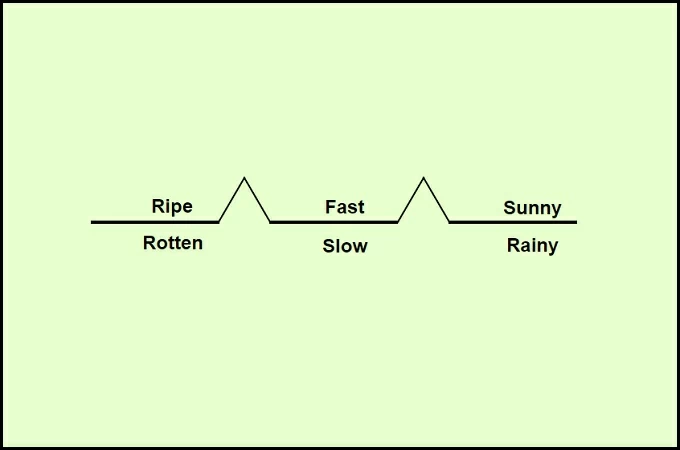
Finally, we have the Bridge Map . Similar to the double bubble map, a bridge map shows the relationship between two or more topics. The similarity ends there because the purpose of this map is to make analogies between different ideas. The map is also not easily readable if you are a beginner because every part corresponds to a different meaning. On the other hand, once you get used to this map, it’ll be easier for you to determine analogies and get the main idea of every bridge map you encounter. Aside from that, you can use this thinking map to create fill-in-the-blank exercises for students.
Using a thinking map is not a new concept for educators and students. However, knowing which map to use at a certain point in time is crucial for a successful lesson. That is why we provided you with all the different forms of thinking maps, and the proper way to use them. This will guide you later on whenever you need to use a map.
Related posts:
- Top 10 Free Flowchart Maker for Windows and Mac
- How to Write a Descriptive Essay for College Students
Leave a Comment
Comment (5).
This website uses cookies that are essential for the operations of this website and its core functions. Other cookies will only be placed with your consent. For more details visit our Cookies Policy .
Tree Essay for Students and Children
500+ words essay on tree.
Tree Essay- Trees are our best friends because they clean the air we breathe. Likewise, they also clean the water and soil and ultimately make the earth a better place. It is also a fact that people who live near trees are healthier, fit, and happier than people who do not.
Moreover, it is our responsibility to look after our friends who serve us in many ways. Most importantly by saving plants, we are not doing any favor to plants but to ourselves only. Because trees and plants life does not depend on us but our lives depend on them.

Importance of Trees
Trees are important to us in a lot of ways and we cannot ignore their importance. They are important because they give us fresh air to breathe , food to eat and shelter/shade from sunlight and rainfall . Besides this, there are many medicines in the market that are made up of trees extracts. Apart from this, there are plants and trees that have medicinal value.
They bring peacefulness; create a pleasing and relaxing environment. Also, they help in reflecting the harmful rays of the sun and maintaining a balanced temperature . Besides, they also help in water conservation and preventing soil erosion . They also manage the ecosystem and from ancient times several varieties of plants are worshipped.
Get the huge list of more than 500 Essay Topics and Ideas
Benefits of Trees
Trees provide us many benefits some of which we can’t see but they make a huge difference. They help in fighting back the climate changes by absorbing greenhouse gases which are the main cause of climate change.
Moreover, they replenish groundwater and filter the air from harmful pollutants and odors. Besides, they are a great source of food and the king of fruits ‘Mango’ also grow on trees.

Moreover, they are the cause of rainfall as they attract clouds towards the surface and make them rain. They can be teachers, playmates and a great example of unity in diversity.
Above all, they are a good source of reducing air, water, and noise pollution.
Value of Trees
When a seed of a plant or tree grow it makes the area around it greener. Also, it supports many life forms. Birds make their nests, many reptiles and animals live on it or near it.
Besides, all these many beautiful flowers, food growing on it. Moreover, many parts of trees such as roots, leaves , stem, flower , seeds , are also edible. Most importantly they never ask anything in return for their services and the gifts they give. Trees also keep the balance in the ecosystem and ecology.
To conclude, we can say that trees are very important and beneficial for every life form on earth. Without them, the survival of life on earth will become difficult and after some time every species starts to die because of lack of oxygen on the planet. So, to save our lives and to survive we have to learn the importance of trees and also have to teach our children the importance of trees.
Customize your course in 30 seconds
Which class are you in.

- Travelling Essay
- Picnic Essay
- Our Country Essay
- My Parents Essay
- Essay on Favourite Personality
- Essay on Memorable Day of My Life
- Essay on Knowledge is Power
- Essay on Gurpurab
- Essay on My Favourite Season
- Essay on Types of Sports
Leave a Reply Cancel reply
Your email address will not be published. Required fields are marked *
Download the App

Tree Map: Five Paragraph Essay
Loading ad...
Claire E Preston
5 paragraph essay: tree map
- Google Classroom
- Microsoft Teams
- Download PDF
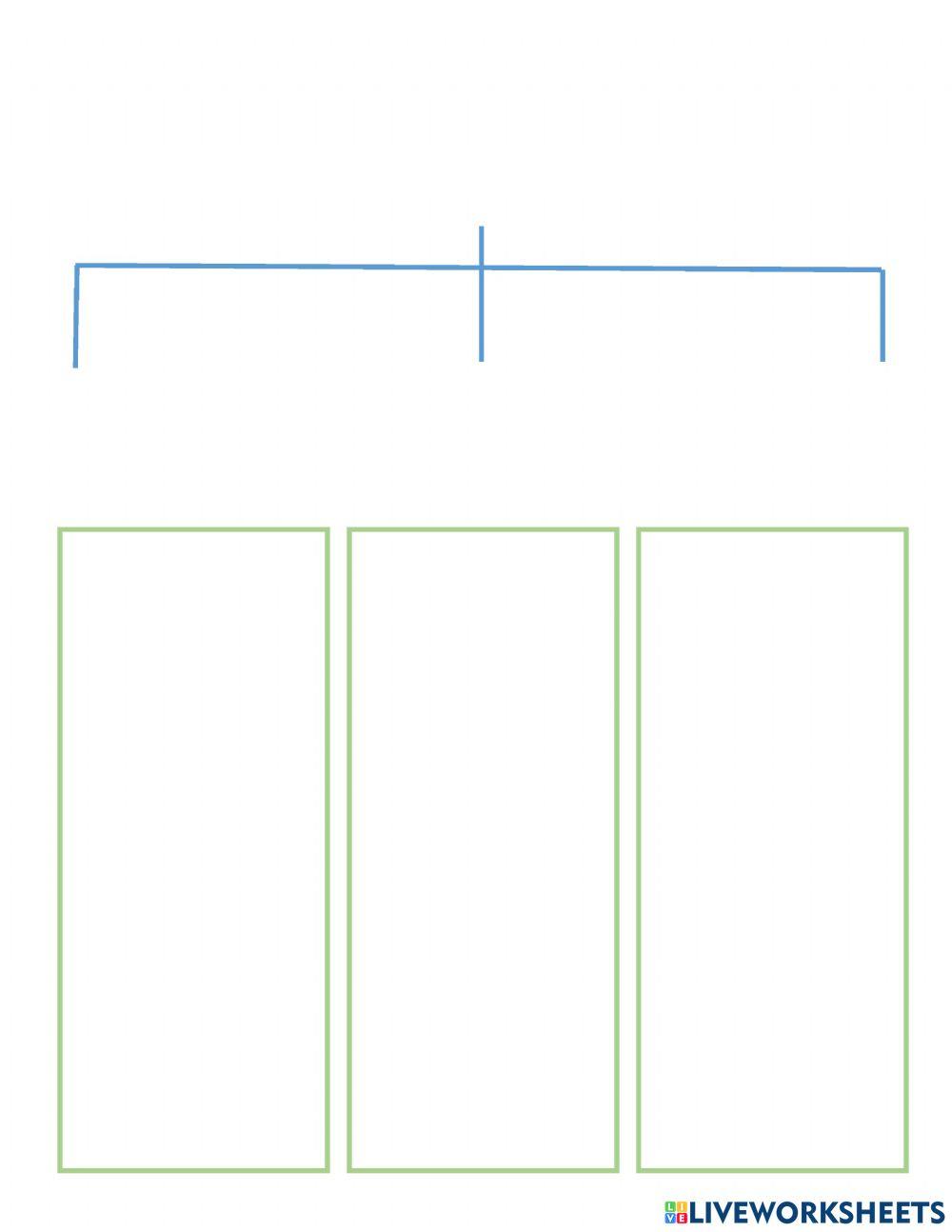
- Article Sample
- Terms & Conditions
- Privacy Policy
Laura V. Svendsen
How safe will my data be with you?
Can i pay after you write my essay for me.
Customer Reviews
Finished Papers
Susan Devlin
We value every paper writer working for us, therefore we ask our clients to put funds on their balance as proof of having payment capability. Would be a pity for our writers not to get fair pay. We also want to reassure our clients of receiving a quality paper, thus the funds are released from your balance only when you're 100% satisfied.
Finished Papers
Don’t Drown In Assignments — Hire an Essay Writer to Help!
Does a pile of essay writing prevent you from sleeping at night? We know the feeling. But we also know how to help it. Whenever you have an assignment coming your way, shoot our 24/7 support a message or fill in the quick 10-minute request form on our site. Our essay help exists to make your life stress-free, while still having a 4.0 GPA. When you pay for an essay, you pay not only for high-quality work but for a smooth experience. Our bonuses are what keep our clients coming back for more. Receive a free originality report, have direct contact with your writer, have our 24/7 support team by your side, and have the privilege to receive as many revisions as required.
We have the ultimate collection of writers in our portfolio, so once you ask us to write my essay, we can find you the most fitting one according to your topic. The perks of having highly qualified writers don't end there. We are able to help each and every client coming our way as we have specialists to take on the easiest and the hardest tasks. Whatever essay writing you need help with, let it be astronomy or geography, we got you covered! If you have a hard time selecting your writer, contact our friendly 24/7 support team and they will find you the most suitable one. Once your writer begins the work, we strongly suggest you stay in touch with them through a personal encrypted chat to make any clarifications or edits on the go. Even if miscommunications do happen and you aren't satisfied with the initial work, we can make endless revisions and present you with more drafts ASAP. Payment-free of course. Another reason why working with us will benefit your academic growth is our extensive set of bonuses. We offer a free originality report, title, and reference page, along with the previously mentioned limitless revisions.
All our papers are written from scratch. To ensure high quality of writing, the pages number is limited for short deadlines. If you want to order more pages, please choose longer Deadline (Urgency).

IMAGES
VIDEO
COMMENTS
A mind map is a diagram that displays information visually. You can create mind maps using pen and paper, or you can use an online mind mapping tool such as MindMeister. Whatever you use, the rules for creating a mind map are simple: 1) Write the subject in the center of your paper / canvas. 2) Draw branches that point away from the center.
Part 3: Branches. After a tree (and your essay) is established with a firm foundation, it is time to "branch out.". Branches add endless variety but always remember, they stem from the trunk. Indeed, a branch lives by the trunk and dies by the trunk. So too do an essay's criteria or sub-topics.
Doing so would suggest that the writer's claim is still speculation, rather than an existing truth which the essay will explain and document. • Very often the thesis statement will include a third element: an essay map. The Essay Map: What It Does. • The essay map lists the ideas or points the writer will use to support the thesis.
According to the mind map essay example, an essay is a written piece in which you convey a certain topic and then back it up with facts, claims, analyses, and explanations. The five-paragraph essay is the most common style of an essay, though an essay can have as many parts as necessary. A 5 essay is comprised of five paragraphs.
Use Essay Map to plan and organize your essays with an interactive graphic organizer. Learn expository writing skills and improve your grades.
Mastering the use of mind maps for essay writing entails three primary steps - identifying an apt essay topic, kickstarting the research process, and finally, outlining your essay within a mind map. ... For instance, the sight branch might have sub-branches like "white snow," "gray skies," or "bare trees." Each of these would break down into ...
Use Essay Maps that were completed by students to create a class-generated essay. Begin by assigning a single topic to the class. Topics for younger or less advanced students might include, "A Description of Our School," "Field Trip Ideas for Our Class," and "Things to Do in Our Town/City.". Topics for older or advanced students can ...
Title Topic + Opinion. Central idea of the entire essay. The focus of all other paragraphs, details and statements is to support it in being true and believable. Be specific. Stay focused. Thesis IDEA #1 IDEA #2 Should support the claim of the thesis and work to show readers how
Maps can be used to analyze or organize different kinds of texts; for example, a student may use a ... a Multi-Flow Map to develop ideas for a cause-and-effect expository piece, or a Tree Map to outline supporting arguments for a persuasive piece. Write from the Beginning…and Beyond training shows teachers how to apply the Maps in the writing ...
The basic structure of an essay always consists of an introduction, a body, and a conclusion. But for many students, the most difficult part of structuring an essay is deciding how to organize information within the body. This article provides useful templates and tips to help you outline your essay, make decisions about your structure, and ...
Grades. Launch the tool! Expository writing is an increasingly important skill for elementary, middle, and high school students to master. This interactive graphic organizer helps students develop an outline that includes an introductory statement, main ideas they want to discuss or describe, supporting details, and a conclusion that summarizes ...
The Essay Map is an interactive graphic organizer that enables students to organize and outline their ideas for writing assignments. Use this graphic organizer to develop an outline for an essay that includes an introductory statement, main ideas, supporting details, and a conclusion. View Resource. $3.00.
To help them focus and include everything they need to I have create thought starters for the various genres that we cover over the school year. Included. in this set are 11 mind maps: -1. circle map- good for any prewriting activity- whole group or individual. -2. cause effect maps: flow map and Flee Map. -1. persuasive writing Flee Map.
Circle Map. The first type and probably the simplest thinking maps type is the Circle Map. As the name suggests, it is a circle in shape. It is most commonly used for brainstorming sessions as it is perfect for capturing the free flow of information. Aside from that, it is the most straightforward map that you can draw with just a pen and paper.
Are you struggling with students unable to organize their ideas? Use this tree map to give them a visual of how their essay should be organized. Page 1 is a visual, page 2 is for students to brainstorm. File is a PDF ready to print. Use with the Argumentative Essay Organizer--both are color coded to...
500+ Words Essay on Tree. Tree Essay- Trees are our best friends because they clean the air we breathe. Likewise, they also clean the water and soil and ultimately make the earth a better place. It is also a fact that people who live near trees are healthier, fit, and happier than people who do not. Moreover, it is our responsibility to look ...
Tree Map: Five Paragraph Essay 5 paragraph essay: tree map ID: 1902566 Language: English School subject: English Language Arts (ELA) Grade/level: 5-12 Age: 10+ Main content: 5 Paragraph Essay Other contents: Graphic Organizer Add to my workbooks (3) Add to Google Classroom Add to Microsoft Teams
PenMyPaper: a student-friendly essay writing website. We, at PenMyPaper, are resolute in delivering you professional assistance to write any kind of academic work. Be it marketing, business, or healthcare sector, we can prepare every kind of draft efficiently, meeting all the points of the question brief. Also, we believe in 'research before ...
Essay Tree Map, How Can I Start An Essay About Yourself, Critical Thinking Using Analytics, Haiti Earthquake 2010 Case Study Geography, A Good Cover Letter Includes Quizlet, Top Assignment Ghostwriter Service Us, Facts About Why Students Shouldn't Have Homework 964
"The Butcher of Rostov" Andrei Chikatilo "Don't blow my brains out, the Japanese want to buy them" A.Chikatilo. Andrei Chikatilo was born on October 16, 1936 in a small village of Ukraine. Chikatilo did not have an easy childhood. He was born with water in his brain, a condition called hydr...
Aksay is a river in Rostov Oblast, Southern Russia. Aksay is situated nearby to the village Alexandrovka and the locality Urochishche Uglovatoye. Photo: Artemka, Public domain. Ukraine is facing shortages in its brave fight to survive.
Aksay is a town and the administrative center of Aksaysky District in Rostov Oblast, Russia, located on the right bank of the Don River, 18 kilometers northeast of Rostov-on-Don, the administrative center of the oblast. Photo: Dmitry89, CC BY-SA 4.0. Ukraine is facing shortages in its brave fight to survive.
Aksay Tourism: Tripadvisor has 441 reviews of Aksay Hotels, Attractions, and Restaurants making it your best Aksay resource.